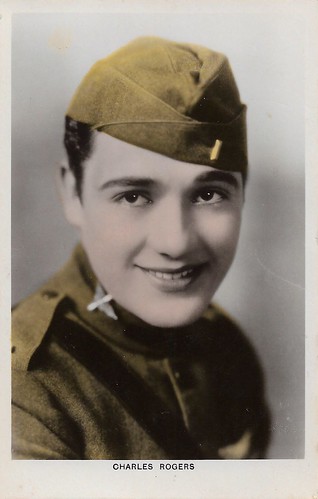
British postcard in the Colourgraph series, London, no. C.26. Rogers wears his outfit from Wings (William Wellman, 1927).

German postcard by Ross Verlag, no. 111/1. Photo: Paramount. Charles Rogers, Nancy Carroll, and Jean Hersholt in Abie's Irish Rose (Victor Fleming, 1928), starring Charles "Buddy" Rogers and Nancy Carroll. It was based on a popular Broadway play.

German postcard by Ross Verlag, no. 3797/1, 1928-1929. Photo: Paramount.

German postcard by Ross Verlag, no. 4326/2, 1929-1930. Photo: Paramount.

German postcard by Ross Verlag, no. 4616/2, 1929-1930. Photo: Paramount.

German postcard by Ross Verlag, no. 4618/1, 1929-1930. Photo: Paramount. Charles Rogers in Illusion (Lothar Mendes, 1929).

German postcard by Ross Verlag, no. 4681/1, 1929-1930. Photo: Paramount. Charles Rogers and Nancy Carroll in Close Harmony (John Cromwell, A. Edward Sutherland, 1929).
One of the first films to show two men kissing
Charles Edward 'Buddy' Rogers was born in 1904 in Olathe, Kansas, to Maude and Bert Henry Rogers. His father was a newsman who later became a probate judge in Johnson County. Charles attended Olathe high school and studied at the University of Kansas where he became an active member of Phi Kappa Psi.
In the mid-1920s, he trained at the Paramount Picture School and began acting professionally in Hollywood films. His film debut was a starring role in the silent romantic comedy Fascinating Youth (Sam Wood, 1926), along with Thelma Todd and Josephine Dunn in supporting roles. That year, he also appeared in the comedy So's Your Old Man (Gregory La Cava, 1926) starring W. C. Fields and Alice Joyce.
Nicknamed "Buddy", his most-remembered film performance was opposite Clara Bow and Gary Cooper in the Oscar-winning war film Wings (William A. Wellman, 1927), the first film ever honored as Best Picture. Hundreds of extras and some 300 pilots were involved in the filming, including pilots and planes of the United States Army Air Corps which were brought in for the filming and to provide assistance and supervision.
Wellman extensively rehearsed the scenes for the Battle of Saint-Mihiel over ten days with some 3500 infantrymen on a battlefield made for the production on location. Although the cast and crew had much spare time during the filming because of weather delays, shooting conditions were intense, and Wings took approximately nine months to complete in total. Acclaimed for its technical prowess and realism upon release, the film became the yardstick against which future aviation films were measured, mainly because of its realistic air-combat sequences.
According to Wikipedia, Wings was one of the first films to show two men kissing, and also one of the first widely released films to show nudity. In the enlistment office are nude men undergoing physical exams, who can be seen from behind through a door that is opened and closed. Bow's breasts are revealed for a second during the Paris bedroom scene when military police barge in as she is changing her clothes.
In the scene in which Rogers becomes drunk, the intoxication displayed on the screen was genuine, as although 22 years of age, he had never tasted liquor before, and quickly became inebriated from drinking champagne. A boom was built with the camera mounted on an extension to shoot the Café de Paris scene. For many years, Wings was considered a lost film until 1992 when a print was found in the Cinémathèque Française film archive in Paris and quickly copied from nitrate film to safety film stock.
It was again shown in theaters, including some theaters where the film was accompanied by Wurlitzer pipe organs. In 1997, Wings was selected for preservation in the United States National Film Registry by the Library of Congress as being "culturally, historically, or aesthetically significant."
Rogers then appeared in the silent romantic comedy My Best Girl (Sam Taylor, 1927) opposite his future wife Mary Pickford. Charles Rosher received an Academy Award nomination for his cinematography of this film in 1928. He co-starred again with Clara Bow in the romantic comedy Get Your Man (Dorothy Arzner, 1927). His first part-talkie was Abie's Irish Rose (Victor Fleming, 1928) with Nancy Carroll. They co-starred again in the musical Close Harmony (John Cromwell, A. Edward Sutherland, 1929).

Austrian postcard by Iris-Verlag, no. 5741. Photo: Paramount-Film.

French postcard by Cinemagazine-Edition, no. 831. Photo: Paramount. Charles Buddy Rogers and Jean Arthur in the pre-Code drama Young Eagles (William Wellman, 1930).

German postcard by Ross Verlag, no. 4618/3, 1929-1930. Photo: Paramount.

German postcard by Ross Verlag, no. 4682/1, 1929-1930. Photo: Paramount. Charles Rogers and June Collyer in the period piece River to Romance (Richard Wallace, 1929), an early sound film.
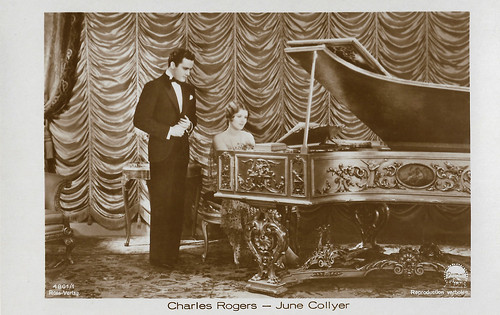
German postcard by Ross Verlag, no. 4801/1. 1929-1930. Photo: Paramount. Charles Rogers and June Collyer perhaps in the early sound film Illusion (Lothar Mendes, 1929).

German postcard by Ross Verlag, no. 4969/1, 1929-1930. Photo: Paramount. Charles Rogers and Nancy Carroll in Illusion (1929).
A sweet and swinging dance band
Charles 'Buddy' Rogers was a talented trombonist skilled on several other musical instruments. He performed with his own dance band in films and on the radio. He performed in such musicals as the all-star American revue Paramount on Parade (Edmund Gouldin, and ten other directors, 1930), and the British musical Dance Band (Marcel Varnel, 1935).
In 1930, he recorded two records for Columbia as a solo singer with a small jazz band accompanying him. In 1932, he signed with Victor and recorded four sweet dance band records with a group organised by drummer, and later actor, Jess Kirkpatrick. In 1933–1934 Rogers took over the popular Joe Haymes orchestra, to which he added drummer Gene Krupa. His later bands were organised by Milt Shaw.
In 1938, he signed with Vocalion and recorded six swing records. During World War II, he served in the United States Navy as a flight training instructor. After making An Innocent Affair (Lloyd Bacon, 1948), he retired from the screen for nine years, concentrating on television and radio work.
His final screen appearance before his retirement from films was in the Western The Parson and the Outlaw (Oliver Drake, 1957). It was produced by Charles 'Buddy' Rogers Productions and distributed by Columbia Pictures. The film stars Anthony Dexter as Billy the Kid, along with Buddy Rogers, Sonny Tufts, Marie Windsor, and Jean Parker.
In 1960, a star on the Hollywood Walk of Fame was dedicated to Rogers at 6135 Hollywood Blvd, for his contribution to the motion picture industry. In 1986, the Academy of Motion Picture Arts and Sciences honored Rogers with The Jean Hersholt Humanitarian Award, and in 1993, a Golden Palm Star on the Palm Springs Walk of Stars was dedicated to him.
In 1937, Rogers became the third husband of silent film actress Mary Pickford. Their romance had begun in 1927 when they co-starred in My Best Girl, but they kept it on ice until Pickford's separation and 1936 divorce from Douglas Fairbanks. According to IMDb, he reported that Clark Gable "once told Mary [Mary Pickford] when we got married, that it wouldn't last six months" because he was 11 years younger than her. They remained married for 42 years until Pickford's death in 1979.
The couple adopted two children — Roxanne (born 1944, adopted in 1944) and Ronald Charles (born 1937, adopted in 1943). He became estranged from daughter Roxanne when, at age 18, she ran off to marry a man her parents did not approve of. In 1982, Rogers married Beverly Ricono, a well-regarded philanthropist in the Palm Desert area, and the couple remained together till his death.
According to Wikipedia, Rogers was reportedly bisexual and had an affair with Gene Raymond who was married to Jeanette MacDonald. IMDb: "Jeanette MacDonald and Gene Raymond were married on June 16, 1937. Nine days later, Mary Pickford and Charles 'Buddy' Rogers were wed. That same night, both couples left aboard the liner Lurline to honeymoon in Honolulu. Their respective cabins were adjacent, and Raymond and Rogers seem to have already been quite well acquainted. According to reliable sources, the two wives found the two grooms commencing a honeymoon of their own."
Charles 'Buddy' Rogers died in Rancho Mirage, California, in 1999, at the age of 94 of natural causes, and was interred at Forest Lawn Cemetery, Cathedral City, near Palm Springs.
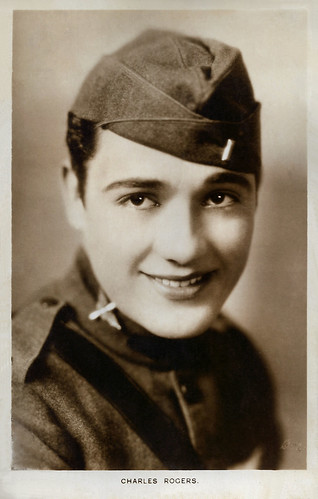
British postcard in the Colourgraph Series, London, no. C 26. Charles Rogers in Wings (William Wellman, 1927).

German postcard by Ross Verlag, no. 5175/2, 1930-1931. Photo: Paramount.

German postcard by Ross Verlag, no. 5175/3, 1930-1931. Photo: Paramount. Charles Rogers in Heads Up (Victor Schertzinger, 1930).
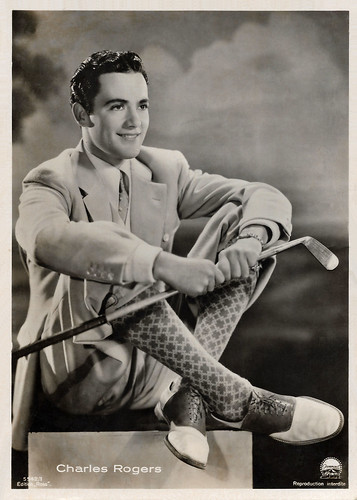
French postcard by Edition Ross, no. 5542/1, 1930-1931. Photo: Paramount. Charles Rogers in Follow Thru (Lloyd Corrigan, Laurence Schwab, 1930).

German postcard by Ross Verlag, no. 5547/1, 1930-1931. Photo: Paramount. Charles Rogers and Nancy Carroll in Follow Thru (Lloyd Corrigan, Laurence Schwab, 1930).
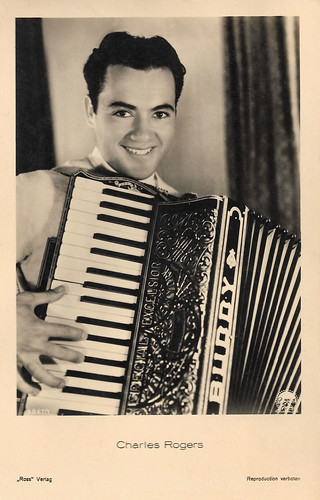
German postcard by Ross Verlag, no. 5667/1, 1930-1931. Photo: Paramount.
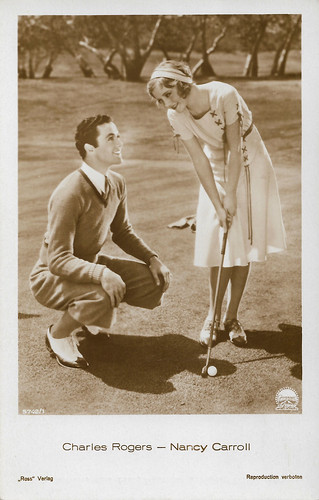
German postcard by Ross Verlag, no. 5742/1, 1930-1931. Photo: Paramount. Charles Rogers and Nancy Carroll in Follow Thru (Lloyd Corrigan, Laurence Schwab, 1930).

German postcard by Ross Verlag, no. 540. Photo: Paramount. Charles Rogers in Heads Up (Victor Schertzinger, 1930).

German postcard by Ross Verlag, no. 6404/1, 1931-1932. Photo: Paramount.
Sources: Find A Grave, Wikipedia, and IMDb.
This post was last updated on 13 May 2021.
No comments:
Post a Comment